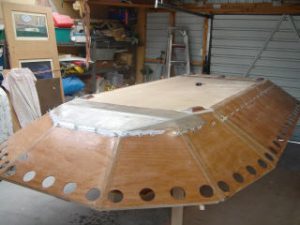As boring as the picture maybe i thought i would add this anyway just to show anyone starting out building a superwedge that the panels prior to fibre glassing get stitched together with wire, (although hard to see in the picture anyway) and to be honest this is a brilliant concept , it saves time and effort and in some cases automatically aligns the plywood edges up. The fiber glassed section you see here is the extension to the length i made so i could fit a subaru engine to it later on.
This picture here is a view of the rear of the cockpit, the reason i added this pic is purely cause i can 🙂 but apart from that its just showing the rear panel that has been “V” grooved with a router and then bent into place, another neat concept as this also saves time and hassles. :-), the masking tape applied to the panel is on the opposite side to the V groove and is there to help prevent the ply splitting to pieces when folded
Here is the view of the rear of the hovercraft , the two upright pieces of ply you see there is a jig made from scrap ply to set the planning panels at the right angle for later, if you look closer you can see a row of Eyebolts along the base of the panels, i used these instead of bending 70 odd metal hooks from wire. I will be covering them with resin later when i fillet and fiberglass all internal seams.









